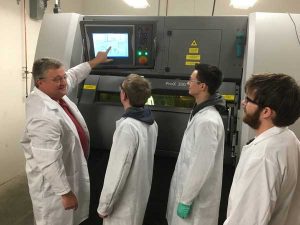
By Jeff Eckhoff, communications manager for the Center for Industrial Research and Service.
The future of modern manufacturing is now being built in the basement of ISU’s Sukup Hall – one 40-micron-thick layer at a time.
Iowa State University’s Center for Industrial Research and Service (CIRAS) has been up and running for roughly a month now – after an extended setup, calibration and training period – on its newly purchased metal laser sintering machine. The machine, which uses the combination of powdered metal and a laser to melt it, is the metal version of additive manufacturing, or what most people commonly think of as 3-D printing.
While plastic additive manufacturing machines (3-D printers) are widely in use, the metal ones are far less common. But the technology they offer is about to change the way companies manufacture and design almost everything. Geometric limits imposed by the production process are going to disappear. Manufacturers will be able to produce parts and products with less material and in days instead of the traditional weeks.
“Everybody has to change their way of thinking about how to make things work,” explains Jim Johnson, chief operating officer at Frog Legs Inc. in Ottumwa. “Otherwise, there will be some companies who change and take all the business.”
Johnson’s firm is one of several Iowa companies now working with CIRAS experts to explore the intricacies of metal additive manufacturing. CIRAS, by helping companies experiment and test the boundaries of this technology, hopes to help Iowa businesses prepare for some projected rapid growth.
“Is this technology ready for everyday use? No,” summarizes Chris Hill, head of CIRAS’ technology assistance initiatives. “But if I as a manufacturer can start getting educated now, then I kind of know what I can do with it. And when the technology gets a little better, then I can take advantage of it while my competitors are still thinking, ‘OK, now I need to start learning about this…’ ”
The new machine is part of a $900,000 investment made in October with money from CIRAS and with generous contributions from ISU College of Engineering, Iowa Economic Development Authority and the federal NIST Manufacturing Extension Partnership. It’s an exciting move for Iowa industry because it offers companies a front-row seat for the next evolution of how things are made.
Additive manufacturing machines follow computerized designs to assemble items one tiny layer at a time. That process differs from the usual method of taking a chunk of steel or a vat of liquid metal and transforming it into a different shape. Because you’re starting from scratch, anything is possible – including odd-shaped parts that simply can’t be produced using traditional manufacturing methods or parts that now require assembly because they can’t be made as a single piece.
“With this, the design rules are broken,” says Jack Ward, a program manager with Quatro Composites, a CIRAS client in Orange City. “Now, I can go do all kinds of crazy stuff, and I can actually build it. Because I can print it, I can do stuff that I couldn’t actually do before.”
CIRAS, alongside Iowa State’s engineering faculty and students, intends to spend the next few years figuring out the best techniques for doing all that crazy stuff. And we’ll be keeping Iowa companies informed about what we find.
Stay tuned.
About the author
Jeff Eckhoff is communications manager for the Center for Industrial Research and Service. He spent 21 years as a newspaper journalist at the Columbia (Mo.) Daily Tribune, Philadelphia Inquirer and the Des Moines Register before joining CIRAS at the end of 2013.